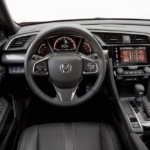In casting a wide-enough net, any well-thought search for a midsize sedan should include a comparison of the 2017 Toyota Camry vs the 2017 Honda Accord. If you’re expecting a close competition between the two, you won’t be disappointed. Ultimately, these have always been two very competitive vehicles, and any decision will rest in the details.
Price
First things first, price will always play a part in any car-buying decision. One of the most noticeable characteristics between these sedans is the close price range in which they fall, regardless of trim level.
Beginning with the (base) LE trim, the Toyota Camry is priced at $23,070 MSRP to start. With trim levels including the SE, XSE, and XLE, the base price maxes out at around $26,310. That said, the Camry does deliver Hybrid options as well, priced to start at $30,140.
The Honda Accord also comes in a variety of trim levels (LX, Sport, Sport Special Edition, EX, and EX-L) all of which are priced relatively close to one another. The (base) LX trim has a starting MSRP of $22,455 while the top-of-the-line EX-L starts at $28,920. For another two grand, there is also the option of upgrading the EX-L to a V6 engine.
At the end of the day, the Accord is priced competitively enough at each trim level to stay ahead of the Camry. That said, price and value are two very different things. In turn, let’s cast a wider look at both vehicles.
(1:0 Accord)
Performance
Depending on the trim level, engine options for the Toyota Camry will differ. Beginning with the LE you can expect the reliability of a 2.5-liter four-cylinder to deliver 178 horsepower and 170 lb-ft of torque. Upgrade to the XSE and XLE and you gain the added confidence of a 3.5-liter V6. At 268 horsepower and 248 lb-ft of torque, it is a worthwhile consideration for any driver that isn’t satisfied with the performance of a 4-cylinder.
Exploring the V6 XSE further, you can expect strong acceleration, well-rated braking, and confident handling. Fuel economy of 30 mpg (highway, 21 city) is average but right on point for a midsize sedan.
For an apples-to-apples comparison, we’ll look at the EX-L trim for the Honda Accord. Also powered by a 3.5-liter V6, the horsepower is relatively consistent with (if not somewhat higher than) that of the Camry. With 272 horsepower and 252 lb-ft of torque, the two remain head-to-head. With 33 mpg (highway, 21 highway), the Accord inches out ahead of the Camry, but only just.
It’s worth noting that the above is based on the performance trims for both the Camry and Accord. Even at this level, it’s easy to see how closely the two fall. An examination of the lower trim levels paints a similar picture, which encourages us to call this one a draw overall.
(1:0 Accord)
Body Design
Once you start discussing the cosmetics of body design, the conversation becomes somewhat subjective. That said, the mid-size sedan class walks a tightrope between the expectations of traditional sedan design that is still embraced by luxury brands, and a more sporty coupe-like feel. While you may prefer the latter, I’ll take the former any day.
To that point, the Camry is more evocative of a luxury sedan. With its long, sloped design that sits low to the ground, it gives a heightened sense of aerodynamic engineering. In contrast, the sportier appearance of the Accord results from a stubbier front-end design and the more drastic angle of the hood meeting the windshield.
With this, the Camry confidently ties things up (1:1)
Interior Design
Having established some favoritism towards the Camry XSE and the Accord EX-L trim levels, it’s worth pointing out that the the Camry XLE is a more accurate point of comparison for the top-of-the-line Accord EX-L. That said, let’s shift our focus accordingly while we explore the luxury of interior comfort and additional amenities.
With the Camry XLE, leather seating enhances a design built around the comfort of all passengers. The driver and front-passenger can expect the added luxury of heated seats, while rear-seated passengers can expect a comfortable ride, courtesy of generous proportions and a contoured design. Often credited with a roominess that exceeds its competition, the Camry sets a strong benchmark.
As expected, the Accord EX-L offers much of the same. If you credit the Camry with spaciousness, any difference in exterior design feels nil when looking at the comfort of the cabin.
It really comes down to nitpicking. The interior design of the Camry XSE could prove more accommodating to passengers with more demanding physiques. The Accord may not be as comfortable for taller drivers or passengers, making the Camry the preferred of the two.
(2:1 Camry)
Infotainment
A premium 10-speaker HD sound system with satellite radio is a great place for the Camry XSE to start. Factor in a 7-inch touchscreen display, Bluetooth connectivity, and a smartphone-based navigation system and it checks most of the boxes. The inclusion of wireless charging is a nice perk, as well.
The Accord EX-L offers some of the more common features, such as bluetooth connectivity and navigation. That said, the sound system is lacking in comparison, and no wireless charging.
Enhancement packaging can be explored for either car, but this is another example of one inching out the other. To that point the Camry takes infotainment. (3:1 Camry)
Final Assessment
Considering our choice of trims, the Camry XSE gains some additional points in terms of starting MSRP. Truth be told, we prefer the Camry over the Accord across-the-board but there are few cars that we’d rate as closely as these two. It really is a subjective comparison, and we encourage you to explore (and compare) the various trims to confirm which is right for you.



